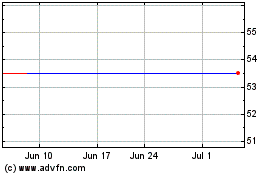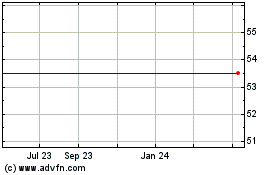Aerospace Industry Executives Express Positive Outlook; Preparing for Rising Interest Rates and Fuel Price Volatility
September 02 2015 - 8:30AM
Business Wire
Exclusive CIT Study Examines the Perspectives
of Airline Fleet and Finance Executives on Current Market Trends
and Their Outlook for the Industry
Aerospace executives are optimistic about the short-term
prospects of their industry, but looming interest rate hikes and
fuel price volatility are compelling them to act, according to an
exclusive online study released by CIT Aerospace, a global leader
in aircraft finance, a division of CIT Group Inc. (NYSE:CIT), a
leading provider of commercial lending and leasing services. The
study, “2015 Aerospace Outlook” (www.cit.com/aerospaceoutlook), was
conducted by Harris Poll among 100 airline fleet and finance
executives.
“Airline executives are taking advantage of current interest
rate levels and low fuel prices to reduce ticket prices, invest in
technology and increase their fleet utilization,” said Jeff
Knittel, President of CIT Transportation & International
Finance. “However, they realize that the market is changing and
many are preparing for future challenges around fuel price
volatility, increased competition and rising interest rates. In
fact, 63% believe higher interest rates will change their company’s
views on purchasing new aircraft and 65% indicate that these higher
rates will cause them to increase the lease content of their
fleet.”
KEY FINDINGS FROM THE
STUDY:
Preparing for Rising Interest
Rates:
- Eighty-one percent of executives agree
that interest rates will rise by more than 1% in the next two
years.
- More than three-quarters (76%) expect
to pay more for financed aircraft as interest rates rise.
Fuel Price Volatility on the
Horizon:
- Sixty-three percent of executives
believe that fuel price volatility will have a positive impact or
no impact on their plans to acquire new technology aircraft.
- Half of executives believe that fuel
prices will increase in the next 18 months, and four out of five
expect them to increase within the next three years.
- Despite the expectation for fuel price
increases in the future, the top three actions taken by executives
to benefit from the current fuel price levels are: hedging at
current fuel prices, reducing ticket prices and increasing
utilization of their current fleet.
Aircraft and Cabin Innovations Highly
Anticipated:
- More than four in five (86%)* believe
that airframers will launch replacement programs for the popular
single aisle market, which will enter into service before
2030.
- Nearly eight in ten (79%)* agree that
used aircraft in the 130-seat category will be in high demand in
the next 10 years due to the current lack of new units in the same
seat category entering the market.
- Seventy-three percent of executives
believe that technology/innovation in aircraft will have the
biggest positive impact on their company in the next five
years.
- Three-quarters of executives (75%)
report that their company already provides, or plans to provide in
the next five years, internet connectivity to passengers on narrow
body and wide body aircraft.
Fleet Leasing Expected To Remain
High:
- Over the next two years, executives say
their businesses plan to increase in-flight sales (60%), the number
of routes (58%) and the number of flights (55%).
- More than half (54%) expect to increase
the number of aircraft over the next two years.
- In five years, executives expect to
lease a higher percentage of narrow body aircraft (on average 52%)
than wide body (on average 33%).
- Executives indicated that lease terms
(62%), a lessor’s responsiveness to their requests (53%) and
efficiency of the lease negotiations process (48%) were the most
important areas when leasing aircraft.
- A significant majority of executives
(65%) believe that their companies will increase the percentage of
leased aircraft in their fleet due to rising interest rates.
About the Study
The study was commissioned by CIT and conducted online by Harris
Poll from February to May 2015 among 100 commercial airline fleet
and finance executives. Among respondents, principle area of their
airlines’ operation was Europe (38%), North America (38%),
Asia/Pacific (13%), South America (5%), Africa (3%) and the Middle
East (3%).
*Note that select questions were asked among a reduced base of
respondents, resulting in a small sample size.
EDITOR’S NOTE:
CIT thought leadership content can be found at View from the
Middle™ (cit.com/viewfromthemiddle) and our CIT Point of View blog
(cit.com/pov). View our corporate video (cit.com/corporatevideo)
and follow us on Twitter, LinkedIn, YouTube and Facebook. Register
to receive press releases at cit.com/newsalerts.
About CIT Aerospace
As one of the world’s leading aircraft leasing organizations,
CIT Aerospace provides leasing and financing packages, including
operating leases and structuring and advisory services, for
commercial airlines worldwide. CIT Aerospace owns, finances and
manages a fleet of more than 350 commercial aircraft serving
approximately 100 customers in 50 countries. cit.com/aerospace
About CIT
Founded in 1908, CIT (NYSE: CIT) is a financial holding company
with more than $65 billion in assets. Its principal bank
subsidiary, CIT Bank, N.A. (Member FDIC, Equal Housing Lender), has
more than $30 billion of deposits and more than $40 billion of
assets. It provides financing, leasing and advisory services
principally to middle market companies across more than 30
industries primarily in North America, and equipment financing
and leasing solutions to the transportation sector. It also offers
products and services to consumers through its Internet bank
franchise and a network of retail branches in Southern California,
operating as OneWest Bank, a division of CIT Bank, N.A. cit.com
View source
version on businesswire.com: http://www.businesswire.com/news/home/20150902005030/en/
CIT MEDIA RELATIONS:C. Curtis RitterSenior Vice President
of Corporate Communications973-740-5390Curt.Ritter@cit.comMatt
KleinVice President, Media
Relations973-597-2020Matt.Klein@cit.comCIT INVESTOR
RELATIONS:Barbara CallahanSenior Vice
President973-740-5058Barbara.callahan@cit.com
CIT (NYSE:CIT)
Historical Stock Chart
From Mar 2024 to Apr 2024

CIT (NYSE:CIT)
Historical Stock Chart
From Apr 2023 to Apr 2024
